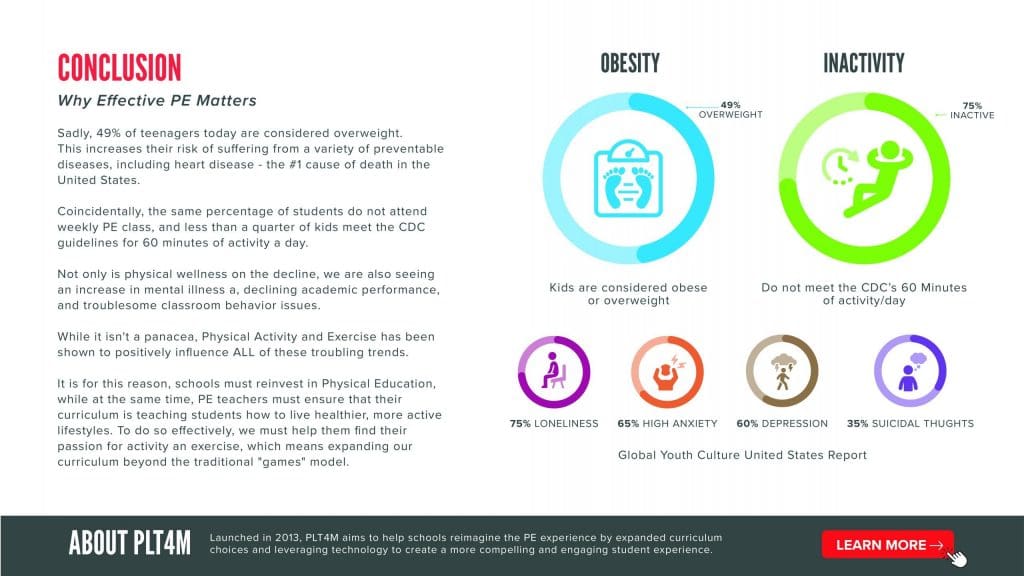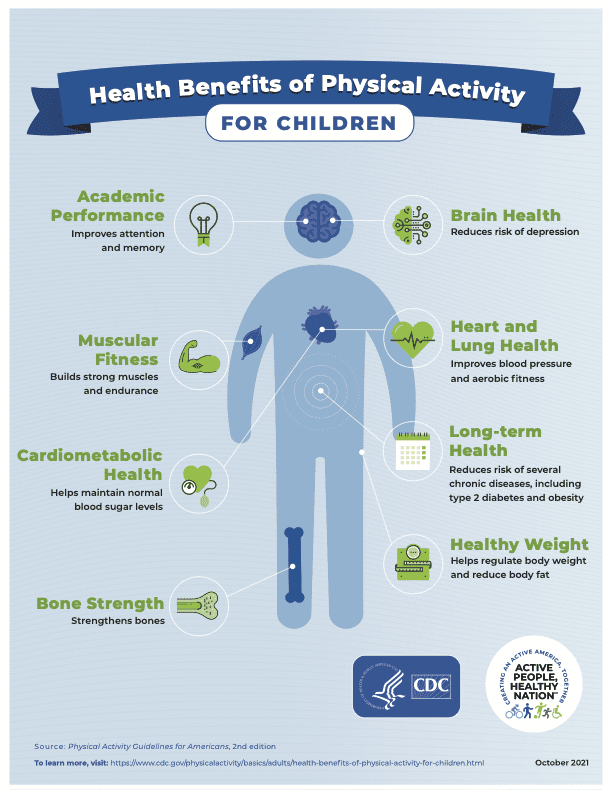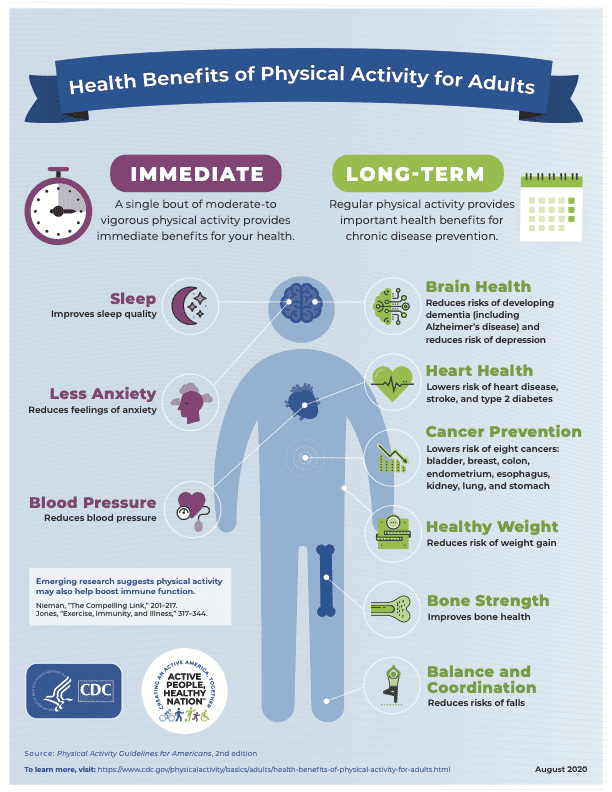The health benefits of physical education schools are well documented. After exploring the current state of student health and wellness, we outline and review the short and long-term health benefits of physical education in schools. In addition, we provide a clear call to action for schools and states to dedicate more physical activity opportunities and daily physical education to empower students.
State of Student Health & Wellness
Before diving into the health benefits of physical education in schools, it is essential to understand the current landscape of student health in the United States:
Physical Health – Childhood obesity amongst children 6-19 is 21.45%, with minority populations and low-income families disproportionately at risk. Less than 25% of children achieve the recommended 60 minutes of physical activity a day. Only 26% of high school-aged students attend PE classes 5 days a week.
Mental Health – 70% of teenagers cited anxiety and depression as the number one problem affecting their peer group. 29% of teenagers self-reported having poor mental health.
Social-Emotional Health – 87% of public schools reported that the COVID-19 pandemic has negatively impacted student socio-emotional development during the 2021-22 school year, with classroom disruptions due to misbehavior at the top of the list.
Academic Performance – Average scores for students in 2022 declined 5 points in reading and 7 points in mathematics compared to 2020. This is the largest average score decline in reading since 1990 and the first-ever score decline in mathematics. 13% of students do not graduate from high school, with minority populations and low-income students disproportionately affected.
Long story short, elementary through high school students are struggling. Higher levels of physical activity and physical education can be powerful tools to combat many of the challenges facing our youth.
Why is physical education important to health? Let’s look at the health benefits of physical education.

Short-Term Health Benefits of Physical Education In Schools
Physical education classes play an important role in the overall health of students. Children of all ages can build physical health, mental health, and social-emotional skills via physical education classes that immediately impact students’ well-being.
The CDC has outlined various “Health Benefits of Physical Activity For Children.” While there are clear differences and distinctions between physical activity vs physical education, the list could certainly be labeled “Health Benefits of Physical Education In Schools.” Regardless of the title, the list includes:
Brain Health – Reduces risk of depression and anxiety.
Academic Performance – Improves attention and memory.
Muscular Fitness – Builds strong muscles and endurance.
Cardiometabolic Health – Helps maintain normal blood sugar levels.
Heart & Lunge Health – Improves blood pressure and aerobic fitness.
Healthy Weight – Helps regular body weight and reduce body fat.
Sleep – Improves sleep quality.
And again, we must reiterate that the health benefits of physical education are not limited to only our very young people in elementary schools. Instead, all grade levels, including high school students, can reap the health benefits of physical education. Daily physical education can be a powerful elixir to combat our youth’s growing mental and physical health concerns.

Long-Term Health Benefits of Physical Education In Schools
The impact of PE classes goes well beyond the school day and year. In fact, PE classes can help instill and support our young people as they transition into adulthood so they can lead long-term healthy lifestyles.
This is because quality physical education doesn’t just help students achieve regular physical activity in the moment. Instead, it helps to empower them with motor skills, physical literacy, and a vast array of other health and wellness tools to promote overall health.
As a result, when students participate in high-quality physical education programs, they are more likely to feel comfortable and confident working out and continuing regular physical activity as adults. Therefore the health benefits of physical education in schools can also be connected to the health benefits of physical activity on adults from the CDC listed below:
Blood Pressure – Reduces blood pressure.
Brain Health – Reduces the risk of developing dementia (including Alzheimer’s disease) and reduces the risk of depression.
Heart Health – Lowers risk of heart disease, stroke, and type 2 diabetes.
Cancer Prevention – Lowers risk of eight cancers: bladder, breast, colon, endometrium, esophagus, kidney, lung, and stomach.
Healthy Weight – Reduces the risk of weight gain.
Bone Strength- Improves bone health.
Balance and Coordination – Reduces the risks of falls.

Physical Education in Schools – Quality, Comprehensive, & Consistent
With a long list of health benefits of physical education in schools, it is essential we have a clear understanding of what physical education programs can and should look like.
While the content and material covered by physical education teachers will vary throughout the United States, there should be some overarching themes. Shape America outlines the three domains of learning in physical education,
“Physical education addresses the three domains of learning: cognitive or mental skills related to the knowledge of movement; affective, which addresses growth in feelings or attitudes; and psychomotor, which relates to the manual or physical skills related to movement literacy.”
But beyond the high-level definitions, it is crucial to be specific and clear about what physical education should look like in schools. Physical education programs should be:
Quality – PE programs are more than just playing sports and “rolling out the ball.” Instead, PE classes have a scope and sequence that builds and develops students’ skills and understanding of different types of physical fitness and exercise.
Comprehensive – Physical education classes introduce and develop a wide range of topics and units ranging in physical fitness, mental health, social-emotional skills, and more. Physical education is an academic subject, just like math or science.
Consistent – To be both quality and comprehensive, physical education teachers need to see students consistently. In some parts of the United States, physical education classes have been reduced to as little as 30 minutes a week for one semester. Schools and states must dedicate more time (150 minutes or more weekly) to physical education.
Check out the quality, comprehensive, and consistent physical education program at Canton High School.
Key Takeaways On The Health Benefits of Physical Education in Schools
We always have big dreams and aspirations for our children and the “next generation.” And while we can make countless investments to improve cognitive performance, academic performance, and social skills, they will all be fruitless if we don’t invest in students’ health and wellness.
The health benefits of physical education in schools create a clear call to action for everyone involved in our children’s school day:
We need to improve the skills and knowledge around physical fitness, the feelings and attitudes towards exercise, and build skills for confidence and competence in various physical activity opportunities.
Sports, recess, and other daily physical activity options are good but cannot serve as students’ only means of physical exercise. Physical education classes are crucial in achieving the recommended 60 minutes of daily physical activity.
Schools must invest in PE programs to see higher levels of success in the classroom and community.
PE programs must be quality, comprehensive, and consistent to unlock the health benefits of physical education in schools.






